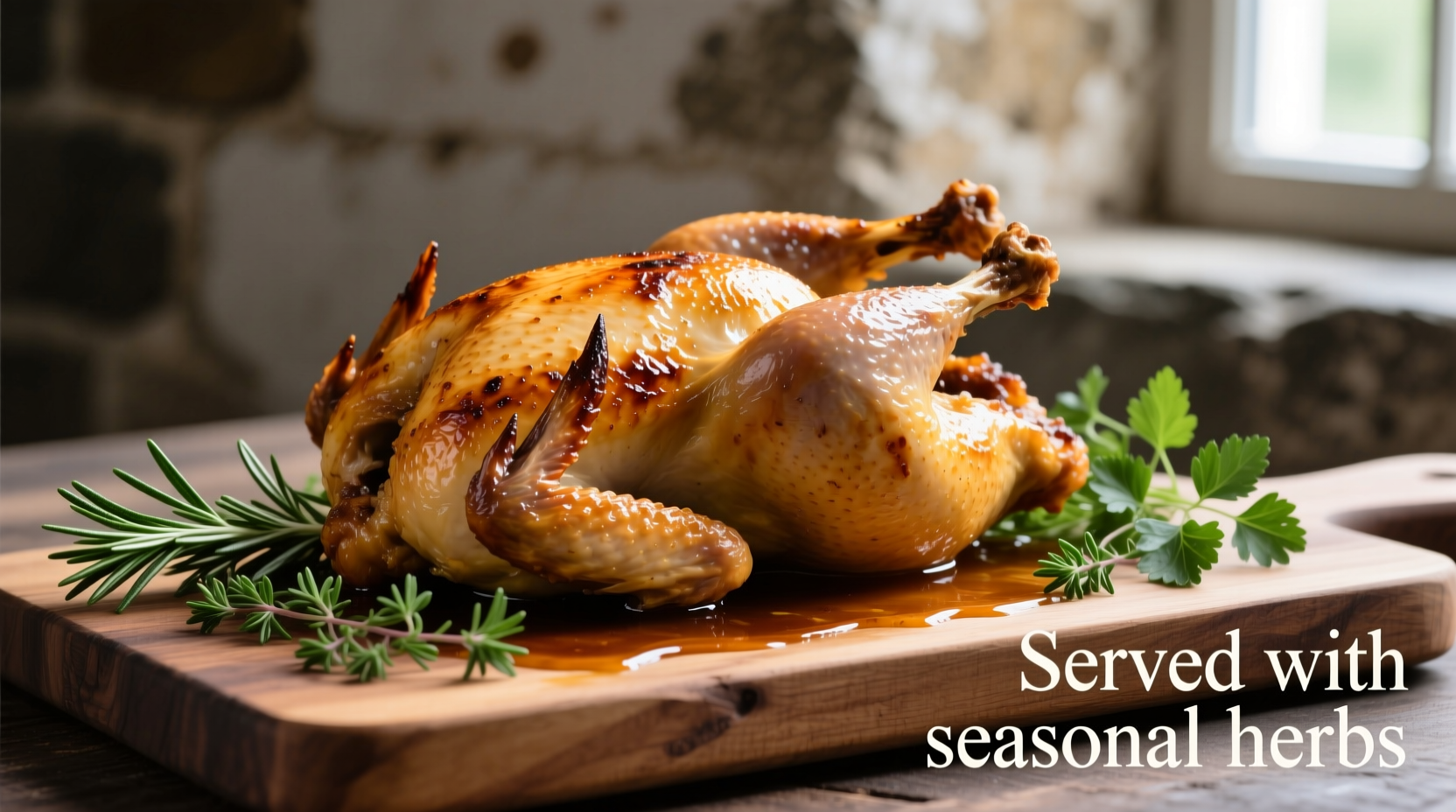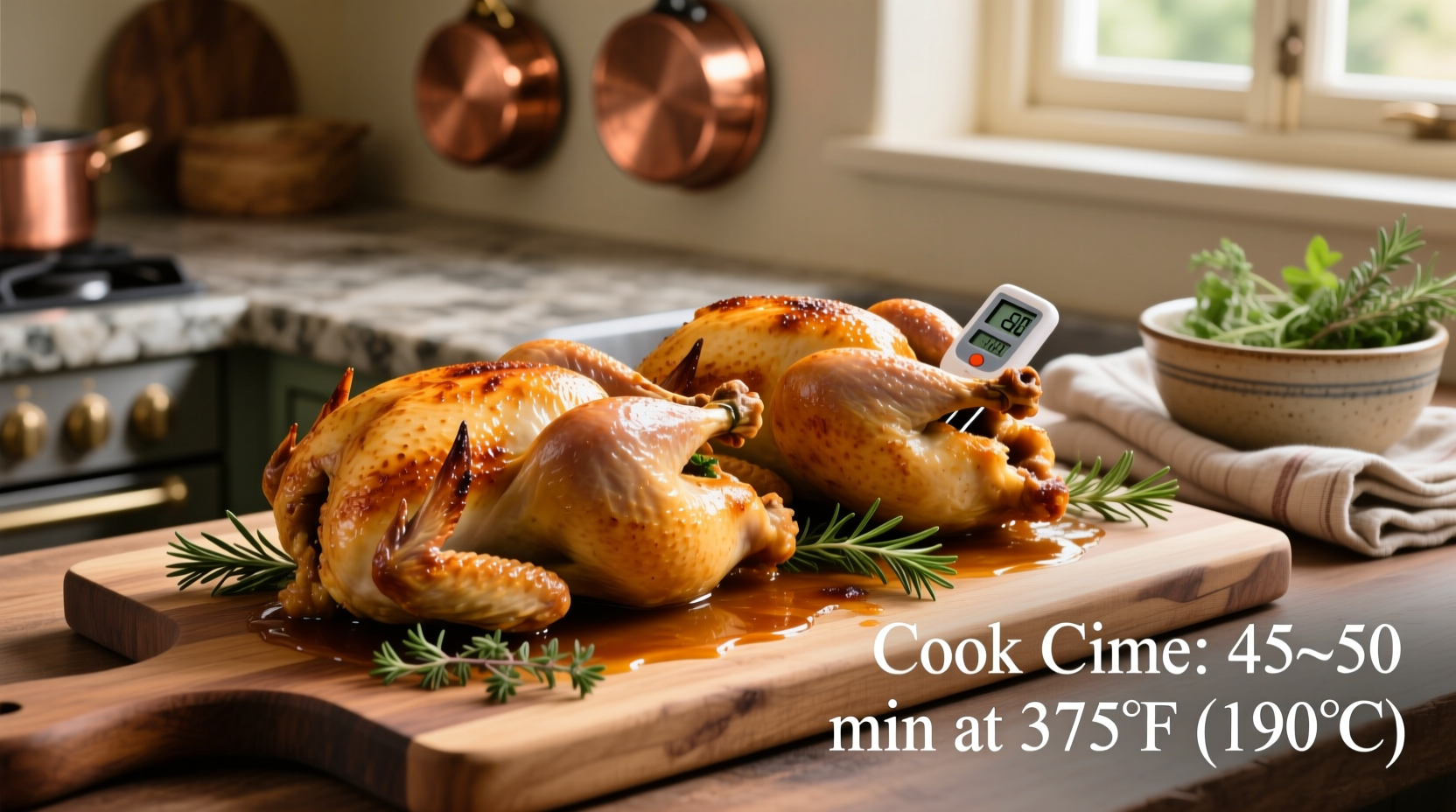Nothing beats the elegant presentation of perfectly roasted Cornish game hens for a special dinner. These petite birds cook faster than regular chickens but require precise timing to achieve that ideal balance of crispy skin and tender, juicy meat. Get your timing right, and you'll serve restaurant-quality results every time.
Why Timing Matters for Cornish Game Hens
Cornish game hens, technically young chickens weighing under 2 pounds, cook significantly faster than standard chickens but demand more attention than turkey or roasting chickens. Undercooking risks foodborne illness, while overcooking transforms their delicate meat into dry, tough disappointments. The sweet spot? 60-75 minutes at 375°F delivers optimal texture and safety.
| Cooking Temperature | Approximate Cooking Time | Internal Temp Checkpoint |
|---|---|---|
| 350°F (177°C) | 70-85 minutes | Check at 60 minutes |
| 375°F (190°C) | 60-75 minutes | Check at 55 minutes |
| 400°F (204°C) | 50-65 minutes | Check at 45 minutes |
| 425°F (218°C) | 45-55 minutes | Check at 40 minutes |
Your Step-by-Step Cooking Timeline
Follow this precise cooking sequence for foolproof results:
- Prep (15-30 minutes before cooking): Remove hens from refrigerator. Pat completely dry with paper towels. Season generously inside and out. Let sit at room temperature while oven preheats.
- Preheat (15-20 minutes): Set oven to 375°F (190°C). Place oven rack in middle position. Verify temperature with oven thermometer.
- Cooking (60-75 minutes): Place hens breast-side up on rack in roasting pan. Roast 45 minutes, then check internal temperature. Continue cooking until reaching 165°F (74°C).
- Resting (10 minutes): Transfer to cutting board, tent loosely with foil. This crucial step allows juices to redistribute.
Context Boundaries: When Standard Times Need Adjustment
While 60-75 minutes works for most scenarios, these common situations require timing adjustments:
- Frozen birds: Add 20-25 minutes if not fully thawed (though complete thawing is recommended)
- Stuffed hens: Increase time by 10-15 minutes and verify stuffing reaches 165°F
- Convection ovens: Reduce time by 10-15 minutes or lower temperature by 25°F
- Multiple birds: Allow extra 5-10 minutes if roasting 4+ hens at once
How to Verify Perfect Doneness
Don't rely solely on cooking time—always verify with these methods:
- Thermometer test: Insert digital thermometer into thickest part of breast, avoiding bone. Must read 165°F (74°C).
- Visual indicators: Skin should be deep golden brown and crisp. Juices should run clear when pierced.
- Leg mobility: Thigh should move freely in its joint when gently twisted.
According to USDA Food Safety and Inspection Service guidelines, poultry must reach 165°F to eliminate harmful bacteria like salmonella. This temperature recommendation has remained consistent since 2006 when the USDA updated their standards from the previous 180°F recommendation, balancing food safety with optimal texture. Source: USDA Food Safety Basics

Troubleshooting Common Cooking Issues
Dry meat? Likely overcooked. Next time, check temperature 5-10 minutes earlier. Consider brining beforehand for extra moisture retention.
Skin not crispy? Pat birds extremely dry before seasoning. Start at 425°F for 15 minutes, then reduce to 375°F. Avoid basting which softens skin.
Uneven cooking? Rotate pan halfway through cooking. For dramatically different sizes, cook separately or shield smaller birds with foil.
Pro Tips for Flavor Enhancement
Professional chefs recommend these timing-sensitive techniques:
- Season under the skin 2 hours before cooking for deeper flavor penetration
- Add lemon quarters and fresh herbs to cavity during last 20 minutes
- Brush with butter or oil mixture at 45 minutes for optimal browning
- Finish under broiler for 2-3 minutes for extra-crispy skin (watch carefully!)
Food science reveals that resting time significantly impacts juiciness. During the 10-minute rest period, the meat's internal temperature continues rising 5-10 degrees (carryover cooking), while muscle fibers relax and reabsorb juices. Cutting too soon releases these precious fluids onto your cutting board rather than keeping them in the meat.
Serving Your Perfectly Cooked Cornish Game Hens
After resting, carve by cutting along the breastbone and separating the legs. Serve immediately with complementary sides like roasted root vegetables, wild rice pilaf, or a bright citrus salad. For special occasions, present whole birds on individual plates for an impressive presentation that requires minimal carving at the table.
Frequently Asked Questions
How do I know when Cornish game hens are done without a thermometer?
Check for clear juices when pierced with a fork, golden brown crispy skin, and legs that move freely in their joints. However, a digital thermometer remains the most reliable method for food safety.
Can I cook Cornish game hens from frozen?
While possible, cooking from frozen adds 20-25 minutes and risks uneven cooking. For best results, thaw completely in the refrigerator for 24 hours before cooking.
Why is my Cornish game hen dry even with proper timing?
Overcooking by just 5-10 minutes can dry these small birds. Verify your oven temperature with a separate thermometer, as many ovens run hotter or cooler than indicated. Brining beforehand also helps retain moisture.
Should I cover Cornish game hens while cooking?
No—covering creates steam that prevents crispy skin development. For evenly browned results, cook uncovered throughout the entire process.











 浙公网安备
33010002000092号
浙公网安备
33010002000092号 浙B2-20120091-4
浙B2-20120091-4